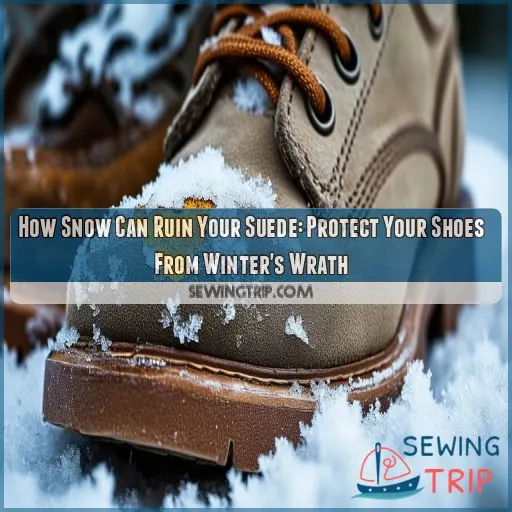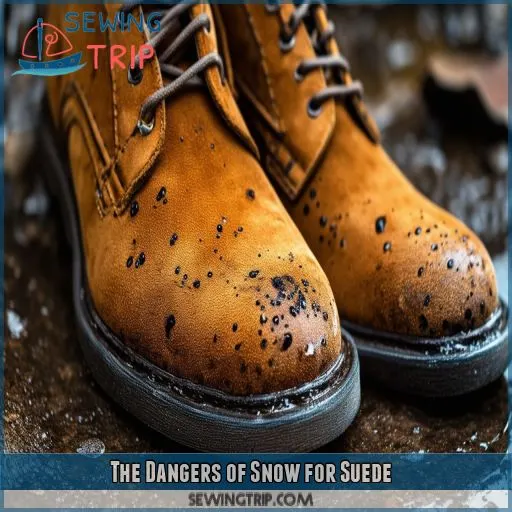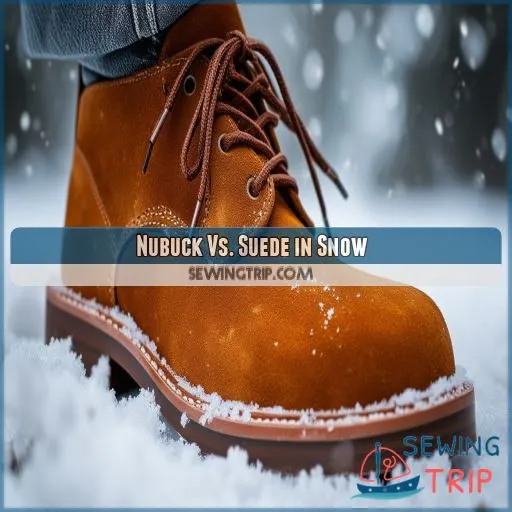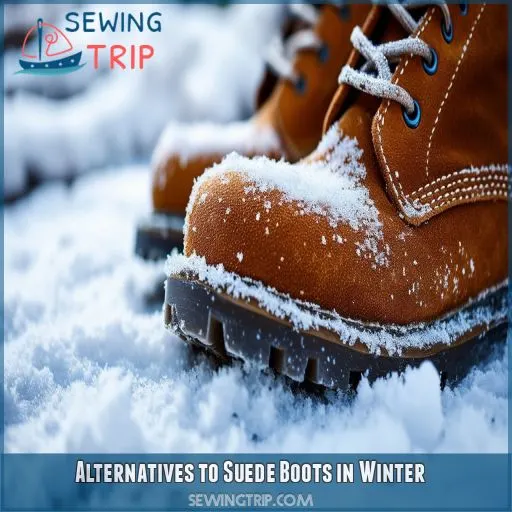This site is supported by our readers. We may earn a commission, at no cost to you, if you purchase through links.

Your once-soft suede can become stiff, cracked, and permanently damaged. To protect your footwear, apply a water-repellent spray regularly and promptly treat salt stains. Opting for darker suede colors can help hide minor blemishes.
If you’re worried about ruining your suede in snowy weather, consider alternatives like treated leather or waterproof snow boots. With the right precautions, you’ll be stepping out in style all winter long.
Table Of Contents
Key Takeaways
- Snow is suede’s kryptonite, turning your stylish kicks into a soggy, discolored mess faster than you can say "winter wonderland." Moisture, salt, and harsh conditions can leave your once-plush shoes stiff as a board and crying for mercy.
- Don’t let Jack Frost nip at your suede! Arm yourself with water-repellent spray and tackle those pesky salt stains like a pro. Remember, an ounce of prevention is worth a pound of cure when it comes to keeping your footwear fabulous.
- Darker suede colors are your secret weapon in the battle against snow damage. They’re like a camouflage jacket for your feet, hiding minor blemishes and giving you a fighting chance against winter’s onslaught.
- When the forecast calls for a winter wonderland, consider leaving your suede beauties safely tucked away. Treated leather or waterproof snow boots might not have the same sex appeal, but they’ll keep your toes toasty without giving you a post-snow panic attack.
How Snow Can Ruin Your Suede?
Snow can ruin your suede by causing discoloration, staining, and permanent texture changes to the delicate material. Exposure to moisture and salt from snow can lead to irreversible damage, making it essential to protect your suede shoes during winter weather.
The Dangers of Snow for Suede
Your beloved suede shoes face serious threats when exposed to snow, including discoloration, staining, and texture changes. These issues can lead to permanent damage, potentially ruining your footwear if not addressed promptly and properly.
Discoloration and Staining
When snow meets your suede shoes, you’re in for a color-changing adventure you didn’t sign up for. The moisture can turn your beloved boots into a darker, stained version of their former selves.
Don’t panic! With proper suede maintenance and stain prevention techniques, you can keep your footwear looking fresh.
Brush regularly, use protective sprays, and tackle discoloration promptly to preserve your suede’s original hue and avoid permanent staining.
Texture Changes
When snow meets your suede boots, it’s not just about stains. The texture can take a hit too. Here’s what you might notice:
- Texture loss: Fibers become matted and lose their softness
- Stiffening: Your once-supple boots feel rigid
- Fading: The rich color starts to dull
- Cracking: Small fissures appear in the material
Don’t let winter wreak havoc on your favorite footwear. Understanding these changes helps you protect your suede from snow’s sneaky assault.
Permanent Damage
Snow and moisture can wreak havoc on your suede shoes, potentially causing irreversible damage. Repeated exposure to winter elements can lead to permanent discoloration, altering your boots’ appearance forever.
The texture may become rough and matted, losing its signature softness.
Road salts are particularly harsh, eating away at the delicate fibers.
Without proper care, your cherished suede shoes might end up as casualties of winter’s wrath.
Nubuck Vs. Suede in Snow
Regarding winter footwear, you might wonder how nubuck compares to suede in snowy conditions. While both materials are leather types, they’ve distinct characteristics that impact their performance in snow. Here’s a quick comparison:
- Durability: Nubuck generally outperforms suede in snow, thanks to its denser fibers.
- Moisture resistance: Nubuck’s tighter grain makes it more naturally water-resistant than suede.
- Winter care: Both require protection, but nubuck needs less frequent treatment.
- Price point: Nubuck often comes with a higher price tag due to its durability.
To care for either material, use a suede brush to remove debris and apply a superhydrophobic spray for added protection. For stubborn stains, gently use a toothbrush with white vinegar or an emery board. Remember, while nubuck holds up better in snow, neither is completely waterproof without proper treatment.
Alternatives to Suede Boots in Winter
- Snow boots: These rugged, waterproof options are built to tackle winter’s worst.
- Leather boots: Treated leather can withstand moisture better than suede footwear.
- Insulated boots: Stay cozy with shearling or synthetic lining for added warmth.
When choosing winter footwear, prioritize waterproofing and insulation. Look for boots with sturdy soles for traction on icy surfaces. If you’re set on wearing suede, apply a protective spray before venturing out. Remember, even with precautions, suede isn’t ideal for snowy conditions. A microfiber towel and soft-bristled brush can help remove light snow, but it’s best to save your favorite suede shoes for drier days. Your feet (and your fashion sense) will thank you!
Caring for Suede in Snow
To protect your suede shoes from snow damage, apply water repellent spray regularly and promptly treat salt stains. Opt for darker suede colors, which are less prone to visible discoloration and can provide added protection against winter’s harsh elements.
Water Repellent Spray
You’ll want to shield your suede from winter’s wrath with water repellent spray. Apply it frequently, especially before snowfall. Use light, even strokes, and let it dry completely.
Store your spray in a cool, dry place. While DIY application works, professional treatment offers extra protection.
Choose a brush compatible with your spray for best results. Think of it as giving your suede a lotus leaf-like superpower against moisture.
Salt Stain Removal
After applying water repellent spray, you’ll still need to tackle salt stains. These pesky marks can darken and discolor your suede.
To prevent them, wipe your shoes clean after each wear. If stains occur, use a specialized suede cleaner in circular motions. For stubborn salt stains, try a mixture of water and vinegar.
Love Your Purse offers professional cleaning services for those tricky cases.
Darker Colors for Protection
After tackling salt stains, consider your suede’s color for added protection. Darker shades are your snow-fighting allies. They’re less prone to visible staining and discoloration, giving you an edge in winter’s battleground.
Color enhancement sprays can boost this durability contrast.
When selecting suede shoes for snowy conditions, opt for rich browns, deep blues, or classic blacks. These darker hues offer superior protection benefits, keeping your footwear looking sharp despite the frosty onslaught.
Frequently Asked Questions (FAQs)
Is it OK to wear suede shoes in snow?
You shouldn’t wear suede shoes in snow. They’re susceptible to water damage and discoloration. Opt for waterproof boots instead. If you must wear suede, apply a protective spray and clean them immediately after exposure to snow.
Does suede get ruined easily?
Like a delicate flower in a storm, suede can be vulnerable. You’ll find it’s not as fragile as you might think, though. With proper care and protection, your suede shoes can weather daily wear and tear quite well.
Does suede get ruined in the snow?
You’ll want to be cautious with suede in snow. It’s not instantly ruined, but moisture can damage and discolor it. Use protective sprays, avoid prolonged exposure, and treat it promptly if it gets wet to maintain its quality.
Does snow stain suede?
Like a snowflake’s icy touch, snow can indeed stain suede. It’ll leave water marks and discoloration, potentially darkening the material. You’ll notice temporary or permanent changes in appearance, depending on how quickly you treat it. Act fast for best results.
Can you wear suede shoes in snow?
You shouldn’t wear suede shoes in snow. The moisture can stain and damage the material. If you must, apply a waterproof spray first and clean them immediately after. Consider waterproof alternatives for snowy conditions.
Does Suede keep you warm in the snow?
Cozy warmth vs. soggy discomfort: suede’s not your winter warrior. While it offers some insulation, it’s no match for snow’s chill. You’ll find yourself with cold, damp feet. Opt for waterproof boots to keep warm and dry in snowy conditions.
Does snow melt on Suede?
Snow does melt on suede, potentially causing damage. As it melts, the moisture seeps into the fibers, leading to discoloration and staining. You’ll need to act quickly to protect your suede from water spots and potential long-term damage.
What happens if you wear suede in the rain?
When it rains, it pours" on your suede troubles. You’ll face potential staining, discoloration, and texture changes. Water can darken the material and leave marks. Use protective sprays and avoid prolonged exposure to preserve your suede’s appearance and quality.
Can suede shoes be repaired after snow damage?
You can repair Snow-Damaged Suede Shoes. Brush off salt stains, use a suede eraser for water marks, and apply a water-repellent spray. For severe damage, seek professional cleaning. Remember, prevention’s better than cure for suede footwear.
How long does suede take to dry after snow exposure?
Ever felt like you’re walking on soggy clouds? After snow exposure, suede takes 24-48 hours to dry completely. You’ll want to stuff shoes with paper, replace it periodically, and keep them away from direct heat sources.
Does the type of snow affect suede differently?
Yes, snow types affect suede differently. Wet, heavy snow can soak through, causing more damage than light, powdery snow. You’ll want to be extra cautious in slushy conditions, as they’re particularly harsh on suede.
Are certain suede colors more resistant to snow damage?
Like a chameleon, darker suede colors blend better with winter’s palette. They’re more resistant to snow damage, showing less discoloration. You’ll still want to protect them, but darker hues offer a bit more forgiveness in snowy conditions.
Can waterproofing sprays completely protect suede from snow?
While waterproofing sprays noticeably enhance suede’s resistance to snow, they can’t guarantee complete protection. You’ll still need to exercise caution. They’ll repel light moisture, but prolonged exposure or heavy snowfall can still cause damage. Regular reapplication is essential.
Conclusion
Snow can ruin your suede like a wolf in sheep’s clothing, but you’re now armed with knowledge to protect your footwear. By understanding the dangers, applying protective sprays, and promptly treating stains, you’ll keep your suede looking pristine.
Consider nubuck or alternatives like treated leather for harsh conditions. Remember, darker colors hide blemishes better.
With these tips, you’ll confidently stride through winter, knowing how to shield your suede from snow’s destructive effects. Don’t let the cold catch you off guard – safeguard your style today.










